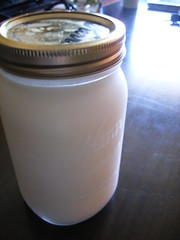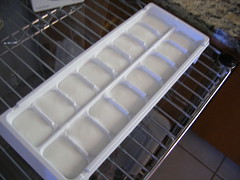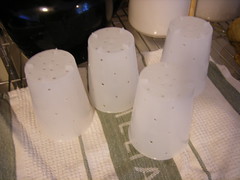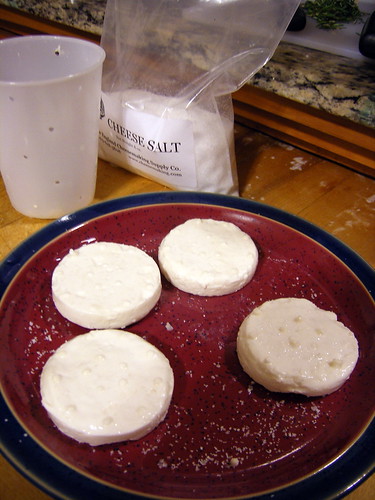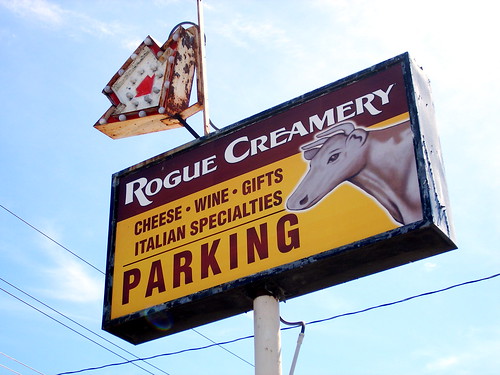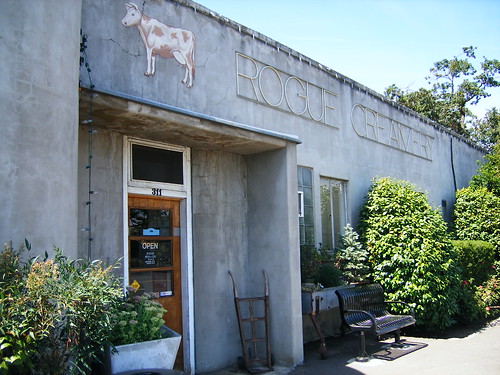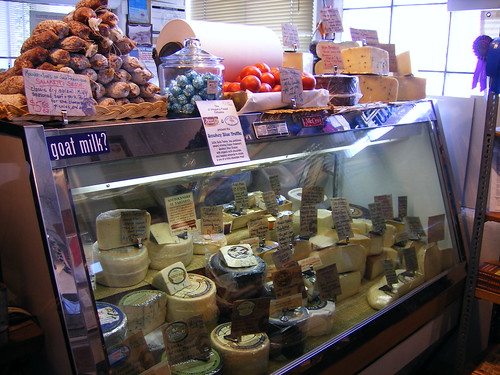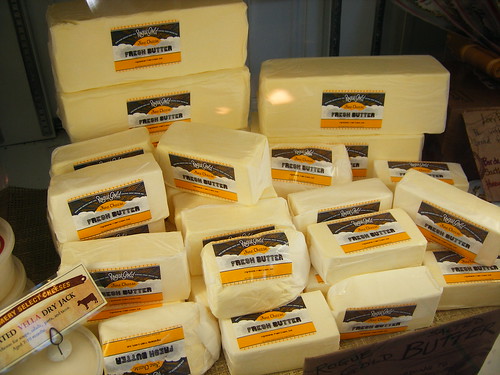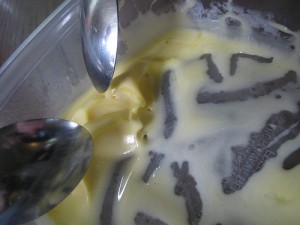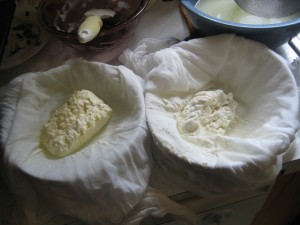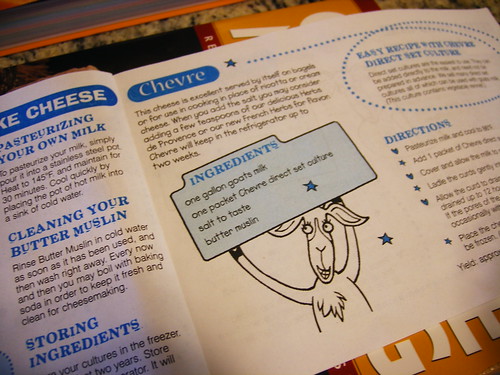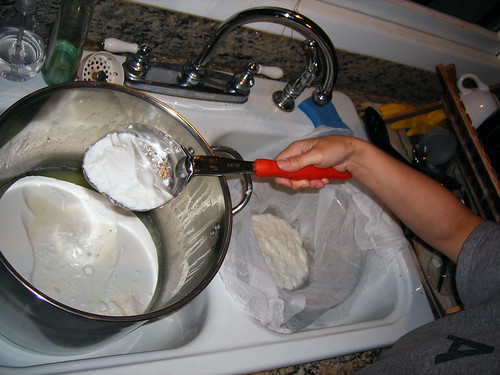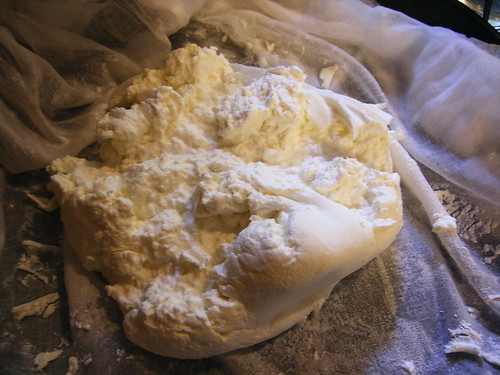Fresh French Style Goat Cheese
After making the chevre, the goat blanc, and the goat milk gelato, we still had a little over a half gallon of goat milk left (frozen) which was just perfect for the Fresh French Style Goat Cheese recipe that came with my goat cheese kit from Ricki Carrol’s suppy company.
This recipe had all sorts of new things to learn: making a culture, keeping the cheese at a high temperature for a long period of time, and using molds. I made a lot of mistakes.
For the culture, I went out and purchased some canning jars and followed the directions. The goat cheese kit comes with a fresh culture packet and directions for how to do this. Basically, you just boil a quart of skim milk and then let it set out and cool. What you should try not to do is permanently warp your husband’s brew kettle and scorch the top of your stove. Which is what might happen if you have a jar sitting on the bottom of a thin metal pot which is also huge because you have no other pot that is large enough to cover the jar. And said kettle hangs over the sides of your burners by a couple inches thus creating a perfectly hot environment, reflecting the heat onto the top of your stove. Oh well, it’s an ugly stove anyway….
After the milk has cooled, you add the culture packet, swirl it around gently and let it sit. I blame the gorgeous weekend combined with family in town that caused me to let it sit a little longer than the 15-24 hours called for… say, 24-48 hours? I cautiously opened it up and it smelled good and looked good so I put that extra 24 hours out of my mind and stuck it in the fridge until I could get around to the cheesemaking.
I took a portion of the fresh culture and used it in the very simple French Style Goat Cheese recipe and then moved on to the next step which was to set the cheese out for 24 hours at 86-degrees. Um… what? There was much consulting of friends and asking around for a friend’s yogurt maker (missing) and suggestions to let it set by a heater for 24 hours (husband) and putting it in a warm oven (mine only goes down to 175) and finally I threw up my hands, wrapped it in a blanket while it was still warm and ignored it. It was a warm-ish day, around 80, and I just didn’t know what else I could do.
I took the leftover culture and froze it in an ice-cube tray which I had previously sterilized in boiling water. Supposedly, you can use a single ice-cube to make another quart of fresh culture. It’s a self-perpetuating system!
So, that’s two mistakes of unknown consequences. In any case, I came back a day later and carefully lifted the lid on the pot (my new Favorit stainless steel pot that I got from IKEA for this purpose) and stuck my nose in there. Smelled good! It was still a bit warm and smelled like yummy goat cheese! Hooray!
I thought that I would need to hang this cheese before putting it in the molds or at least weighting it in molds to get the whey out but the directions said just to put it in the molds, turning them occasionally. I filled the molds about 3/4 full with the jelly-like curds and whey and set them in a casserole dish and covered it with cloth to keep cats and flies away.
I was so dubious at this point. It just seemed like things would just sit there. It was like a miracle when I lifted the cloth about ten hours later to see about an inch and a half of whey sitting in the dish. I drained that off and left it for a whole day, draining it off once more. Basically, the cheeses just got firmer and firmer and the whey just drained off of its own accord. When all that was left was about a 1/2″ puck of cheese I pulled them carefully out of the molds, sprinkled them with cheese salt (does not come in the kit), wrapped them up in wax paper and put them in the fridge.
The most important thing — how did they taste? Well, my husband and I smeared a good helping on some roasted garlic bread which we got from the bakery and it’s pretty good. I think it needs more salt and some herbs. I’m going over today to meet the other cheese ladies (we’re making a press!) and I’ll bring this for spreading over bagels. I think they need a little herbs as well. It’s so hard to tell how much salt to use. Obviously, you don’t want to oversalt but salt really does make the flavor emerge and really makes the cheese. When we did the fromage blanc, it didn’t really achieve a state of total tastiness until we added salt. And the fresh chevre which we made was really amazing once we added the fresh herbs and salt.
There are two notes on rennet with this recipe. One says that if the cheese comes out too rubbery then you are adding too much rennet. The other note says that if too much curd comes out the holes when you put the cheese in the molds then you did not add enough rennet. A little curd came out the holes and the cheese seems a little more on the rubbery side than I thought it would. So, I guess it’s just right? I don’t know. This recipe really brought home how many variables there can be in cheeses and how complicated things can get. On the other hand, with all my little mistakes and uncertainties, these came out pretty well. On a third hand, in the middle of all of this, with family visiting, I managed to make a very delicious blueberry ice-cream which everyone enjoyed. The end.

